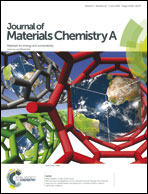Sodium borohydride hydrazinates: synthesis, crystal structures, and thermal decomposition behavior†
Abstract
Metallic borohydride hydrazinates are novel boron- and nitrogen-based materials that appear to be promising candidates for chemical hydrogen storage. Herein, sodium borohydride hydrazinates, including NaBH4·N2H4 and NaBH4·2N2H4, were synthesized via a facile solution synthesis approach based on the solid–liquid reaction between NaBH4 and hydrazine in tetrahydrofuran (THF) solution. The crystal structure of NaBH4·2N2H4 was solved to a monoclinic structure with unit cell parameters a = 8.4592(2) Å, b = 11.7131(2) Å, c = 6.4584(1) Å, and β = 100.0777(14)°, with space group A1a1 (9). Each Na+ ion interacts with four neighboring N2H4 molecules, leading to the formation of Na4[N2H4]44+ cationic chains along the a direction. Such cationic chains are surrounded by BH4− anions. The NaBH4·xN2H4 (x = 1, 2) was characterized by Powder X-ray diffraction (PXRD), Fourier transform infrared spectroscopy (FTIR), thermal gravimetric analysis (TGA), differential scanning calorimetry (DSC), and mass spectroscopy (MS) to obtain a full picture of the relationship of the structure to the decomposition, which will be useful for future work on borohydride hydrazinates or the study of other B–N materials. Furthermore, magnesium borohydride hydrazinates were synthesized by ball milling the sodium borohydride hydrazinates with magnesium borohydride, and their thermal decomposition was investigated as well.


 Please wait while we load your content...
Please wait while we load your content...